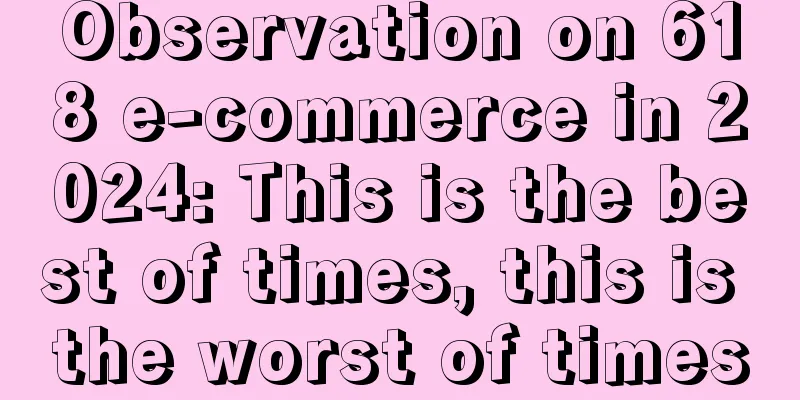Observation on 618 e-commerce in 2024: This is the best of times, this is the worst of times

In the 19th century, the greatest British writer, Charles Dickens, wrote in the opening of his novel A Tale of Two Cities:
More than a hundred years have passed, and this passage is still widely circulated. Interestingly, this passage is quite appropriate to describe today’s Chinese e-commerce industry, especially the most brutal 618 in history that just passed. Despite its shortcomings, the e-commerce industry is still a rare bright spot among many industries in China. Taking advantage of this 618, we try to analyze the e-commerce industry landscape and future trends. The main contents of the article include:
1. 2024 618 Data InsightsAfter the 618 shopping festival, everyone is most concerned about the GMV data of various platforms. The most widely circulated data is a set of data from Star Chart:
It can be said with certainty that the data in the star map is wrong . The reason is simple: First, according to data from the State Post Bureau, the volume of packages during the 618 shopping festival this year increased by more than 20%.
Of course, the package volume is not equivalent to the GMV growth rate, because the increase in return rate and the decrease in average order value will eliminate the correlation between the package volume growth rate and the GMV growth rate. However, compared with last year, the increase in return rate and the decrease in average order value are limited, and the combined impact will not exceed 10% - this is basic common sense, and the package volume growth rate during this year's 618 was actually between 23% and 24%, so the industry's GMV growth rate should be in double digits, and 10-15% is more reasonable. Second, according to data from the National Bureau of Statistics, the cumulative growth rates of total online retail sales of physical goods from February, March, April and May this year were 14.4%, 11.6%, 11.1% and 11.5% respectively. The growth rate in May is higher than that in April, which means that the monthly growth rate in May is far more than 11.5%. The statistical period of 618 this year is from May 20 to June 18. Since the growth rate from May 20 to May 31 is far more than 11.5%, the growth rate of the entire interval is -7%, which means that the growth rate from June 1 to 18 must be around -20%. This probability is probably infinitely close to 0. Combined with the package volume data in the first point, 99.9% of the total online retail sales of physical goods in June also increased, it’s just a matter of how fast the growth rate is. Third, according to the above-mentioned statistics bureau data, it can be calculated that the online retail sales of physical goods in May was 1092.5 billion, while the GMV of the entire network according to Star Map data was only 742.8 billion, which is only 68% of the statistics bureau data. In the statistical period of Star Map, Taobao counted 29 days, JD.com counted 19 days, Pinduoduo counted 30 days, Douyin counted 26 days, and Kuaishou counted 29 days. Except for JD.com, the other platforms were basically around 29 days. The average number of days on these platforms was about 87% of May (31st). Even if calculated according to 87% of the statistics bureau data in May, it should be 951.5 billion, and it is impossible to be only 742.8 billion. Moreover, the average daily sales during the 618 period must be higher than the average daily sales in May. Therefore, even according to the statistics bureau and the statistical time of Star Map, the GMV of 618 this year should be more than 1 trillion. If the platform's own statistical caliber is used, and the unified time period from May 20th to June 18th is used, the GMV will be much larger. Fourth, according to basic common sense, China's total retail sales of consumer goods have been growing for the past 17 months, reaching 4.1% as of May, with no signs or possibility of turning negative in June. The growth rate of online retail sales of physical goods has been 7-8 percentage points faster than that of total retail sales, which means that the e-commerce industry is still a driving factor for the growth of total retail sales, and it is impossible for it to suddenly become a drag in just one month. Fifth, JD.com released a set of battle reports after the end of 618. Although it did not disclose GMV data or growth rate, it clearly stated that "this year's GMV and order volume set historical records." As we all know, JD.com's GMV growth rate in the past three or four quarters has basically been the slowest among Taobao, Pinyin and JD.com, not to mention live streaming e-commerce. Since JD.com's GMV during 618 has been growing, there is no reason for the industry's GMV to be negative, and as high as -7%. Sixth, after the 618 shopping festival, international investment banks such as Citi and HSBC also released relevant reports. Citi clearly pointed out that "we question the data collection method of Star Chart": (From Citi’s 618 research report) HSBC cited data from Analysys, the National Bureau of Statistics, the Postal Administration and Star Map, and tended to choose Analysys' data as a reference. (From HSBC's 618 research report) Furthermore, HSBC pointed out that the reason for the distortion of Star Chart data is that "due to the new promotion methods and application functions introduced by platforms such as BABA, (Star Chart's) poor data collection methods may have undermined the accuracy of trends based on data crawling." Following HSBC's analysis, I can personally provide two more specific perspectives. First of all, from the introduction on Star Map’s official website, it is not difficult to learn that Star Map’s data pool is the sales data of more than 100,000 brands, and the data of the entire network is predicted based on the sales trends of these more than 100,000 brands. This method was relatively accurate before 2020. Why? Because the Chinese e-commerce market at that time was in the branding stage and there was a trend of consumption upgrading. More than 100,000 brands could basically represent the overall picture of the e-commerce industry. However, in the past three years, the core driving force of China's e-commerce market has been consumption downgrade and the resurgence of white-label and small and medium-sized businesses. Taotian Group has been "returning to Taobao, returning to users, and returning to the Internet." We can also see some clues from the battle report released by Taotian after 618.
Brands are still growing, but at this stage, small and medium-sized businesses have stronger growth momentum, and Star Map’s core data is still more than 100,000 brands. Secondly, recommendation algorithms have become increasingly popular on major platforms, especially live-streaming e-commerce platforms. An important feature of recommendation algorithms is that they have strong explosive power for new brands and new stores, because the algorithms can concentrate traffic in a short period of time and create miracles. This also means that the growth of old stores is likely to be limited, and growth is more reflected in new forces. Data collection models such as Star Map are unlikely to update the collection library as quickly as recommendation algorithms and continuously track new brands, which will cause its data to lag significantly behind the actual growth rate. Well, we have basically finished talking about Star Map’s data. In fact, just like HSBC’s choice, I personally prefer Analysys’ data. Let’s first take a look at Analysys’ 618 data, and then talk about why Analysys’ data is closer to the real situation. The time period is uniformly cut from May 20 to June 18. The year-on-year growth rate of Taobao and Tmall is 12%, the year-on-year growth rate of JD.com is 5.7%, the growth rate of Pinduoduo is 17.7%, the growth rate of Douyin is 26.2%, and the growth rate of Kuaishou is 16.1%. The average growth rate of the five major mainstream e-commerce platforms is 13.6%, the average growth rate of comprehensive e-commerce Taobao, Pinduoduo and JD.com is 11.2%, and the average growth rate of live streaming e-commerce Douyin and Kuaishou is 24.3%. During the entire 618 period (May 20-June 18), the sales of comprehensive e-commerce platforms accounted for Taobao's 62%, JD.com's 23.8%, and Pinduoduo's 14.2%. From a full-year or daily perspective, Pinduoduo's GMV should have surpassed JD.com and ranked second in China. However, Pinduoduo's daily sales are relatively smooth, and the peak and valley effects of big promotions are not as good as other platforms, especially big promotions such as 618 and Double 11. Its industry share at such special nodes will be lower than that of daily ones. This has always been the case in the past, and friends who are familiar with the e-commerce industry should also know this. Looking at the five major e-commerce platforms, Taobao accounts for 49.5%, JD.com accounts for 19%, Douyin accounts for 16.6%, Pinduoduo accounts for 11.3%, and Kuaishou accounts for 3.6%. Why do we say that iResearch’s data is likely to be closer to reality? The year-on-year growth rate of the entire industry is 13.6%, and the growth rate of comprehensive e-commerce is 11.2%. This data is close to the physical feeling and is also in line with the data trend of the National Bureau of Statistics. It is about 10 percentage points different from the growth rate of parcel volume of the Post Office. It is in line with our judgment range of the impact of increased return rate and decreased average order value. These are one of the reasons. Secondly, although the growth rate of the live streaming e-commerce industry has declined, it is completely inconsistent with the actual experience to say that the growth rate is 12% as shown in the Star Map data. After all, Kuaishou's e-commerce still had a growth rate of 28.2% in the first quarter. We learned from a reliable source within Kuaishou that the possibility of their 618 growth rate being lower than 12% is zero. Public data shows that Douyin's growth rate exceeded 50% in the first quarter. Although it fell below 40% in April, the possibility of the overall growth rate of 618 falling below 20% is zero. Therefore, the 12% growth rate of live streaming e-commerce in the Star Map data is completely unreliable. The average growth rate of 24.3% of iResearch is very consistent with the actual experience. Third, when Alibaba released its financial report on May 14, management shared at the performance meeting that the growth in April and May (up to May 14) continued the good momentum of the first quarter, which means it was still growing in double digits, so the 12% growth rate during the 618 period was completely reasonable. In addition, judging from the growth trend of China's total retail sales and online retail sales of physical goods in the past 17 months, the data from Analysys is more credible. 2. Industry structure and trend observationIn terms of growth rate, the growth rate of live streaming e-commerce platforms is still faster than that of comprehensive e-commerce, but the GAP between the two is shrinking significantly, indicating that the potential energy of live streaming is slowing down. Considering that the shelf model is a new driving force for the growth of live streaming e-commerce platforms, it means that the growth rate of pure live streaming e-commerce may have been lower than 20% during the 618 period, which is very close to comprehensive e-commerce. The development of the shelf model of live streaming e-commerce, in the final analysis, still needs to return to supply chain management such as brands, stores, SKUs, and return to the essence of the e-commerce industry such as price, logistics, and services. The momentum driven by traffic has been exhausted. Of course, the slowdown in the growth of live e-commerce is also related to the tightening of content supervision, and live streaming by experts faces certain pressure. After about three years of blind rush, after a complete delivery cycle of 18-24 months, brands will calculate the long-term ROI and re-examine the value of different channels based on comprehensive factors such as the tone of different channels, the potential for attracting new customers, and the cost of maintaining old customers. At such a stage, we tend to believe that after the excitement, the market will return to calm, and brands will pay more attention to long-term business value. The importance of product pricing will be raised to a new level, and their bargaining power in front of influencers will be significantly improved. The supply chain value of live streaming e-commerce channels will also begin to stand out. Therefore, it is reasonable and logical for platforms to actively adjust their development strategies and allocate more free traffic to brand store live streaming rooms rather than influencers. After the traffic growth of live e-commerce platforms slowed down, the traffic allocated to each live broadcast room also decreased synchronously. According to HSBC's research report data, the sales of several top live broadcast rooms decreased by 70%. It can be seen that the bargaining power of big Internet celebrities has also decreased significantly. During last year's Double Eleven, there was still discussion in the public opinion field about the "lowest price on the entire network" of some live broadcast rooms. This year, during 618, most anchors and their promotions about price cuts disappeared. Although the growth rate of comprehensive e-commerce during this year's 618 was slightly slower than that of live streaming e-commerce, it actually performed better and the momentum is leaning in this direction. The reason is simple. In the e-commerce value chain, "more, faster, better" has always been firmly in the hands of comprehensive e-commerce, which has a much stronger infrastructure. Only the value point of "saving" has been undermined by super internet celebrities. Therefore, we have seen that in the past three years, comprehensive e-commerce has had no way to stop brands from cutting prices. As the top internet celebrities are under more or less pressure, brands are re-examining pricing power and the value of different channels. The value competition between comprehensive e-commerce and live streaming e-commerce over "savings" is becoming balanced. Comprehensive e-commerce with scale advantages, mental advantages, infrastructure advantages and value chain advantages is likely to return to the Iron Throne. Specifically, Taotian has made a great comeback this time, with a year-on-year growth rate of 12%, 0.8 percentage points faster than the average growth rate of 11.2% of comprehensive e-commerce. This is the first time that Taotian has achieved this in the past five years, which may mean that Taotian’s strategy of "returning to users and being user-centric" is bearing fruit. On the other hand, as we mentioned earlier, brands are also adjusting their strategies. This trend is consistent with Taotian’s genes, because Taotian is the world’s largest one-stop brand management platform; JD.com has defended its home court, and its GMV and order volume continue to set new historical records; although Pinduoduo’s growth rate has declined, it is still the fastest growing among comprehensive e-commerce companies. In the past, it has performed well in the white-label and industrial belt fields. Now the brand may return to the center of the e-commerce industry, and this is exactly the opportunity that Pinduoduo hopes to break through. This also tells us that we may have reached the end of the era of pure traffic-driven gameplay. There was a time when all brands were forced to use price to exchange for traffic from top influencers, and now this obsession with traffic is starting to backfire on brands. After the price cuts disappeared, buyers' attention shifted back to whether the product itself was attractive enough, whether the quality was good enough, whether returns and exchanges were convenient, etc. One feeling that merchants had during the 618 shopping event this year was that consumers had become more demanding, with a higher return rate. The return rate on comprehensive e-commerce platforms was several percentage points higher than in previous years, and on live streaming e-commerce platforms it was even higher, with some women's clothing merchants even seeing a rate of more than 80%. This is the sequelae of the traffic-only era. Users don’t like to return and exchange products repeatedly. The high return rate can only mean that the product quality is too poor, and the cost of the high return rate will definitely be passed on to the product pricing. In the end, it is ordinary consumers like us who bear all the consequences. When there is a traffic dividend, businesses that rely on traffic to make a one-time deal can not only survive, but also live well. Now, live streaming e-commerce platforms have also entered a period of stability, and the increase in traffic cannot keep up with the merchants' desire for traffic. Major e-commerce platforms have begun to focus on encouraging low prices and "good services" and facilitating returns and refunds. The merchants who can still survive today are definitely not such merchants. Times have changed. If you don’t want the return rate to soar, you must convince consumers with products that can retain them and provide good supporting services while being price competitive. Otherwise, even if there is a lot of traffic coming in, it will be a waste of money. Only with good products, good prices and good services can consumers trust and recognize the brand. If brands can return to the center stage of the e-commerce industry and firmly grasp the pricing power, the production and manufacturing links will have reasonable profits, factories will not be so competitive, workers will not be so tired, and their income will not be so meager; more high-quality jobs will be created in the commodity circulation field, there will be sufficient brand marketing budgets, the media will have a place to live, advertising companies will have work to do, and with more high-quality jobs, the service industry will have long-term development value. If someone believes that commodity profits should be as thin as possible, but at the same time expects the average social income to continue to grow. This is like wanting a horse to run without eating grass. The average social wage is closely related to the profit rate in the field of commodity production and circulation. The internal circulation in the e-commerce, manufacturing and retail industries is still spreading. If the current model of extreme internal circulation is allowed to continue, don’t ask who will be the cost, everyone may be the cost. A few days ago, a number of conflicts occurred in the stores of coffee brand Manner in Shanghai, all of which were caused by the store staff being unable to tolerate the customers' difficulties. A little digging into the Manner incident will reveal that conflict is inevitable. What is the price of getting high-quality hand-brewed coffee at a low price? It is a cramped operating environment and a tense work pace. In the process of rapid expansion, the lack of profits will inevitably lead to labor exploitation. If you are not an exploited employee, you may be a consumer facing employees whose emotions can explode at any time.
People are embarking on the road to heaven. Low-price competition is intensifying, the return rate is rising steadily, and refunds are popularized throughout the entire network, and consumers' shopping experience is soaring. People are heading towards the gates of hell. Behind the bottom-line price war is the extreme compression of costs, the continuous decline in quality, the bad money driving out the good money, and the law-abiding consumers silently bearing the hidden increase in the cost of high return rates. The profits of the entire manufacturing and commodity circulation industries are becoming increasingly thin, and survival is becoming increasingly difficult. Therefore, wages are cut, employees are laid off, stores are closed, and factories are withdrawn. Our average income and consumption expectations are damaged. Under the vicious cycle, people are heading towards the gates of hell. The e-commerce industry is heading towards a fork in the road. In fact, it is not just the e-commerce industry that is heading towards a fork in the road. Author: Zouma Finance, Official Account: Zouma Finance |
<<: How I increased my company's followers by 300,000 through an event
>>: Will column-based operations definitely increase community activity?
Recommend
What does self-fulfillment mean for new Amazon sellers? How to do it?
More and more novice sellers choose to open stores...
How can I remove products sold by Shopee? How can I remove products from the shelves?
Merchants who open stores on Shopee will get some ...
Where is the Amazon Outlet Sale? What does it mean?
In order to help Amazon sellers deal with inventor...
Announcement on the launch of the new version of Dunhuang.com's credit guarantee service
In order to comprehensively improve the service qu...
How much does it cost to transfer a Shopee store? How is the fee charged?
The stores on the Shopee platform can also be boug...
2024 "Internet Giant Narrative List"
In 2024, major Internet giants have launched fierc...
Can the SKU deleted by Amazon still be used? How to add SKU to Amazon?
Amazon is one of the world's largest e-commerc...
How to find Amazon affiliate distributors? How to distribute?
Amazon Affiliate is an advertising affiliate progr...
Do I need to speak a foreign language to open a Shopee store? How to open a successful Shopee store?
Everyone thinks that you must know English to do c...
Entrepreneurs should ignore the efforts after the decimal point
As entrepreneurs, we often overlook the efforts af...
Brand is the center of business management? !
Brand, once considered a small part of marketing a...
How to make more money from TikTok? Remember these 12 words
Is it difficult to make money on Douyin? How can y...
"Wen Huijun"'s Magic Red
The "Yu Wenliang phenomenon" has ended, ...
What is the magic of rural internet celebrities?
In the process of modernization, everyone is runni...
Why is the “anti-human” niche track the secret to success for Vlog creators?
In the current fierce competition in the Vlog trac...









